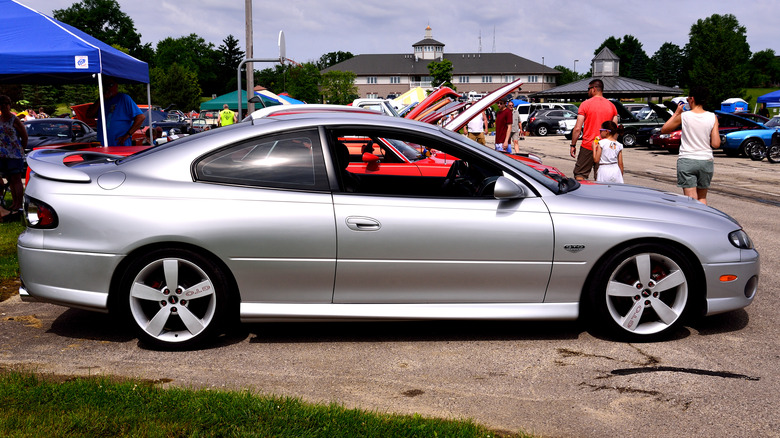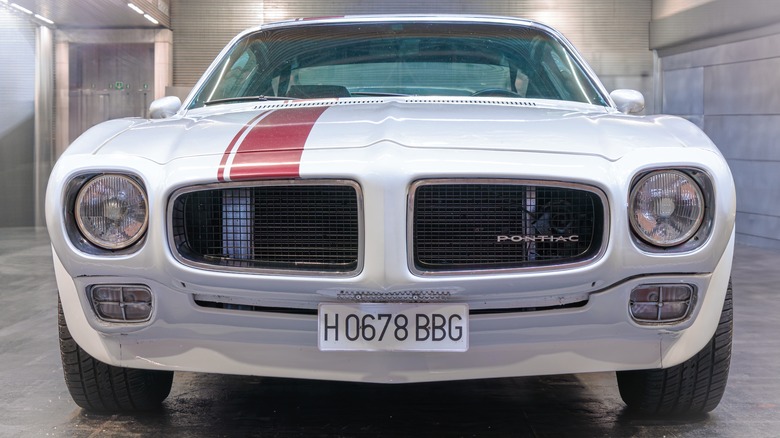5 Underrated Pontiac Models That Deserve A Spot In Your Garage
For many, Pontiac defined an era. In the days when muscle cars dominated the market around the 1960s and 1970s, the General Motors brand was a name to be reckoned with. It appealed to enthusiasts for its exceptional yet practical performance and stylish quality, finding an ideal middle ground. But Pontiac had been around long before then, with it history spanning all the way back to the earliest years of the 20th century, putting it at the forefront of the automobile industry's growth within American society.
Sadly, its years were numbered. General Motors would pull the plug on its iconic brand entering the 2010s decade in response to the then-recent Great Recession. Having not been in production now for nearly a decade and a half, it's safe to say that the Pontiac won't be reclaiming the world's attention as it did in its glory days. As a result, newer generations may have a harder time appreciating the value of some of the brand's most popular vehicles, let alone those that may not have made as much of a splash even among the biggest fans. But like the legacy of Pontiac itself, these cars are never forgotten. It's time we give some of Pontiac's most underrated rides their rightful time in the spotlight and describe what makes them all worthy additions to any collection.
Pontiac GTO
Pontiac holds a special place in automobile history, and much of that status can be attributed to the release of the iconic Pontiac GTO in 1964. Often recognized as launching the popularity of the muscle car in America during the 1960s, the GTO took an exciting step forward by placing a powerful V8 engine into a mid-sized coupe. This was largely done as a response to General Motors placing a ban on the creation of race vehicles. Wanting to still appeal to the younger buying crowd, Pontiac went on to break new ground.
The first generation, which would see alterations from 1964 to 1967, proved to be far more successful than executives expected. Three additional generations followed between 1968 and 1974, but none took off in quite the same way, with both the third and fourth generations only lasting a year each. The 1973 model in particular has garnered a newfound appreciation in recent years from Pontiac fans. While lacking the power of its predecessors, it is nevertheless fondly remembered for its superb handling and unique body and roof style.
Another 30 years would pass before GTO returned for its fifth and final generation. Released between 2004 and 2006, this was done as a way of appeasing the muscle car crowd following the retirement of the Firebird. While its design fell short of fan's expectations — as did its sales — it has since gone on to be deemed an underrated vehicle, with a surprising amount of power offered by is 6.0-liter V8 engine and rear-wheel drive.
Pontiac Grand Prix
In 1962, the Pontiac Grand Prix would hit the streets. Initially designed on the body of a Pontiac Catalina coupe and blended with features of the Boneville, the Grand Prix would go on to create a class all its own, combining the best of both muscle and luxury vehicles.
The initial model included standard interior features such as a center console, vinyl bucket seats, and nylon loop carpets. Its engine was similar to that of the GTO, with a 389 cubic inch V8 engine sporting up to 303 horsepower, although buyers could also go with a Tri-Power version that exerted up to 376 horsepower. Perhaps being named after a world championship race was enough to predict a victory for Pontiac's nameplate, as it sold well with over 30,000 models put out in its first year, which only went up the for 1963 and 1964. Things started to see a dip with the introduction of the second generation model in 1965 once the GTO came on the scene.
Certain models received more love than others, with the 1968 Grand Prix selling only a little more than 31,000 models during its run, despite possessing a mean 390 horsepower engine and a classic look. Similarly, the 2005-2008 generation, the eighth and final of the Grand Prix's run, had its fair share of perks too. While not quite as stylish as some of its predecessors, it nevertheless stood out from your average four-door, with features such as a 5.2-liter V8 303 horsepower engine and a speed-based response component imbued into its traction control.
Pontiac Firebird
With a name like "Firebird," you know you're dealing with a mean machine. This, alongside the Chevy Camaro, would be General Motor's response to the unprecedented success of the Ford Mustang. Pontiac's effort, released to the public in 1967, harboring many of the brand's distinct trademarks such as a slat located in the grille's center and rear slit tail lights while incorporating a more contemporary Coke bottle style. This first generation ran for only three years, but proved to be another success for Pontiac, selling over 250,000 models.
The second generation lasted significantly longer, running from 1970 to 1981. However, the challenges that came with this era had an undeniable effect on the Firebird. In an effort to comply with new safety and emission regulations, the Firebird increased in weight while decreasing the power of its engine. But this and its following generation going from 1982 to 1992 weren't without their highlights, with the 1977 Trans Am edition famously featuring in the Burt Reynolds box office hit "Smokey and the Bandit" and the 1982 Trans Am appearing in the series "Knight Rider." The Firebird's last generation, released between 1993 and 2002
Even if these latter generations didn't quite match the Firebird's glory days, it's nevertheless admirable to see the efforts put in by Pontiac to keep the muscle car era alive, at least in terms of design. Even its last generation kept up with the sleeker look, which few other Pontiacs that entered the 21st century pulled off as effortlessly. If you're seeking a mean looking car but aren't too keen on aggressive driving, it's a worthy and stylish addition to your garage.
Pontiac 2+2
The downside of being a game-changing brand like Pontiac is that not every risk taken results in success. Case in point, the Pontiac 2+2, which undeniable ranks among the most underappreciated muscle cars from Pontiac. General Motors had ambitious visions for the model, hyping it up as the "big brother" of the Pontiac GTO. And it wasn't all bark and no bite either. While the 2+2 was relatively small compared to other Pontiac models, it sported some impressive upgrades, going from a 389 cubic-inch V8 engine for its debut in 1964 to a 421 cubic-inch V8 engine the following year.
Sadly, we never got to see what the 2+2 could've had truly added up to at the end. By 1967, Pontiac transitioned the 2+2 back to only being available as trim for the Catalina, although this did little to save its abysmal sales numbers. That same year would be the 2+2's last stand before Pontiac pulled the plug on production. If you're lucky enough to come across this rare ride, you'll be enjoying a superbly sixties car that, even if it never fully hit its stride, represents the forward-thinking dynamism of the Pontiac name.
Pontiac Solstice
In the midst of Pontiac's end towards the end of the 2000s decade, one of the last notable nameplates to come from the company would release with the Pontiac Solstice. It seemed a fitting end to Pontiac's legacy, bringing the brand's distinct styling and performance features to the modern day. Sadly, it was buried by the larger circumstances plaguing the manufacturer at the time.
Debuting in 2006 as a GXP edition, the Solstice was General Motors' attempt to make a rear-wheel drive roadster with such features as manual transmission, light curb weight, and convertible capabilities. Despite not sporting the most powerful Pontiac engine out there, with the GXP version sporting a 2.0-liter engine that only reached 260 horsepower, it still managed to impress with its practicality and superb handling when driving through winding roads and similarly tight spaces. A targa top coupe version followed in 2009 and the nameplate continued to garner a strong reputation from the likes of Autoweek, Motor Trend, and Autombile Magazine to name a few, with many comparing it favorably to the Mazada Miata.
With the end of Pontiac in 2010, the Solstice sadly went down with it, with only a handful made in 2010. There was talk of keeping the Wilmington assembly plant to continue manufacturing the Solstice with the intent of it being adopted by another company, but these plans were soon shelved, with Wilmington itself eventually being acquired elsewhere.





